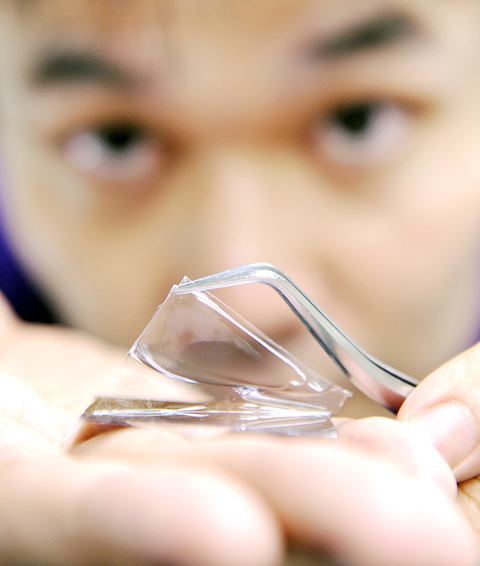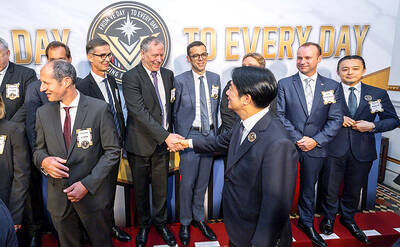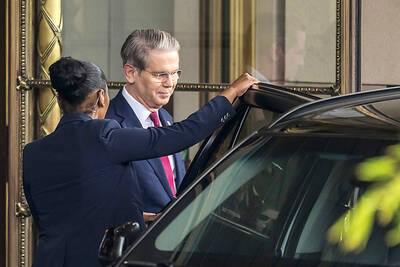The Internet has changed many things, of course, but one of its more far-reaching effects has been to transform the economics of innovation.
Big corporate research and development laboratories — at IBM, General Electric (GE), Hewlett-Packard and a handful of other companies — have their roots and rationale in the industrial era, when communication was costly, information traveled slowly and social networks were fostered at conferences and lunchrooms instead of over the Web.
Crowdsourcing and other new, more open models of innovation are really byproducts of the low-cost communication and new networks of collaboration made possible by the Internet.

PHOTO: AFP
So, in the Internet era, what is the continuing role and comparative advantage of the corporate research and development (R&D) lab?
Its role will be smaller and its advantage diminished, said Michael Schrage, a research fellow at the Center for Digital Business at the Sloan School of Management at the Massachusetts Institute of Technology (MIT). The idea-production process, Schrage said, will continue to shift away from the centralized model epitomized by large corporate labs, going from “proprietary innovation to populist innovation.”
Much of traditional corporate R&D spending, he said, has been subsidized by profits that are increasingly under Internet-era pressures.
“The economic case for a lot of in-house R&D no longer makes sense,” Schrage said.
The best bet for corporate R&D labs, he said, is to adopt a “federated” model that leverages all the innovative work by outsiders in universities, start-ups, business partners and government labs. The corporate lab’s role, then, is to be more of a coordinator and integrator of innovation, from both outside and inside the company walls.
Though hardly alone, Hewlett-Packard has aggressively adopted that approach in the last two years, after Prith Banerjee became the senior vice president for research. Under Banerjee, former dean of engineering at the University of Illinois at Chicago, HP Labs has not only narrowed its focus, placing larger bets on fewer projects, but has also systematically sought outside ideas.
HP now runs a yearly online contest, soliciting grant proposals from universities worldwide. The company lists eight fields in which it is seeking advanced research, and scientists suggest research projects in those fields.
The HP grants are typically about US$75,000 a year, and many of the collaborative projects are intended to last three years. In June, the company announced the 61 winners from 46 universities and 12 countries, including 31 projects receiving a second year of funding.
“We are tapping the collective intelligence, selectively, of leading academics around the world,” Banerjee said.
Alan Willner, an electrical engineer at the University of Southern California, is one of those academics. He is an expert in photonics, using light photons instead of electrons to transmit information. The goal of the project with HP is to cut power consumption and increase data-transmission speeds between computers in data centers, and eventually even inside of chips.
The HP project, he said, supports a research student, provides insights from HP scientists and has helped double the productivity of his research team, whose members have co-authored 21 conference and journal papers related to the project in the last year.
Another name on all those papers is Raymond Beausoleil, an HP research fellow. The USC team, Beausoleil said, has helped fill a gap in photonics expertise in the company’s research program and accelerated its progress. He said that HP Labs has long worked with university professors, but that the outreach tended to be informal and ad hoc.
“Before,” he said, “there wasn’t necessarily a mandate to collaborate.”
Opening up is a good approach to some problems. But tight-knit teams inside corporate labs, experts say, can outshine the open model when working on multidisciplinary challenges in projects soon heading to market.
GE built up a biosciences unit, starting in 2004, to help push its diagnostic imaging technology to new commercial frontiers. Last year, GE and the University of Pittsburgh Medical Center developed a prototype scanner that sharply cuts the time needed to digitize images on pathology slides.
Now, the GE researchers are working on the software and data analysis tools to look into such images for a deeper understanding of diseases. GE is collaborating with Eli Lilly and the Memorial Sloan-Kettering Cancer Center. But the core is a 15-person team at GE Research that includes computer scientists, molecular biologists, chemists and statisticians.
“It really helps to have the close and constant communications loops within the team, because engineers have to learn a lot of biology and biologists have to learn a lot of engineering,” said Fiona Ginty, a bioinformatics scientist who leads the project.
Probably more than any other company, IBM has successfully reinvented its R&D labs over the years, analysts say. Jolted by its early-1990s tailspin, IBM opened its labs to the outside world and to customers. Since the mid-1990s, it has sharply shifted its research focus toward its growth engines of software and services.
IBM is a major underwriter of open research in universities, but also collects more patents for its own use than any other company, year after year.
The open innovation model, said John Kelly, senior vice president and director of research, has many advantages. But he points to several innovations that became products after originating in IBM labs.
“You can’t leave discovery completely to others and to chance,” he said.

DEFENDING DEMOCRACY: Taiwan shares the same values as those that fought in WWII, and nations must unite to halt the expansion of a new authoritarian bloc, Lai said The government yesterday held a commemoration ceremony for Victory in Europe (V-E) Day, joining the rest of the world for the first time to mark the anniversary of the end of World War II in Europe. Taiwan honoring V-E Day signifies “our growing connections with the international community,” President William Lai (賴清德) said at a reception in Taipei on the 80th anniversary of V-E Day. One of the major lessons of World War II is that “authoritarianism and aggression lead only to slaughter, tragedy and greater inequality,” Lai said. Even more importantly, the war also taught people that “those who cherish peace cannot

Taiwanese Olympic badminton men’s doubles gold medalist Wang Chi-lin (王齊麟) and his new partner, Chiu Hsiang-chieh (邱相榤), clinched the men’s doubles title at the Yonex Taipei Open yesterday, becoming the second Taiwanese team to win a title in the tournament. Ranked 19th in the world, the Taiwanese duo defeated Kang Min-hyuk and Ki Dong-ju of South Korea 21-18, 21-15 in a pulsating 43-minute final to clinch their first doubles title after teaming up last year. Wang, the men’s doubles gold medalist at the 2020 and 2024 Olympics, partnered with Chiu in August last year after the retirement of his teammate Lee Yang

The Philippines yesterday criticized a “high-risk” maneuver by a Chinese vessel near the disputed Scarborough Shoal (Huangyan Island, 黃岩島) in a rare incident involving warships from the two navies. The Scarborough Shoal — a triangular chain of reefs and rocks in the contested South China Sea — has been a flash point between the countries since China seized it from the Philippines in 2012. Taiwan also claims the shoal. Monday’s encounter took place approximately 11.8 nautical miles (22km) southeast” of the Scarborough Shoal, the Philippine military said, during ongoing US-Philippine military exercises that Beijing has criticized as destabilizing. “The Chinese frigate BN 554 was

US Secretary of the Treasury Scott Bessent and US Trade Representative Jamieson Greer began talks with high-ranking Chinese officials in Switzerland yesterday aiming to de-escalate a dispute that threatens to cut off trade between the world’s two biggest economies and damage the global economy. The US delegation has begun meetings in Geneva with a Chinese delegation led by Chinese Vice Premier He Lifeng (何立峰), Xinhua News Agency said. Diplomats from both sides also confirmed that the talks have begun, but spoke anonymously and the exact location of the talks was not made public. Prospects for a major breakthrough appear dim, but there is